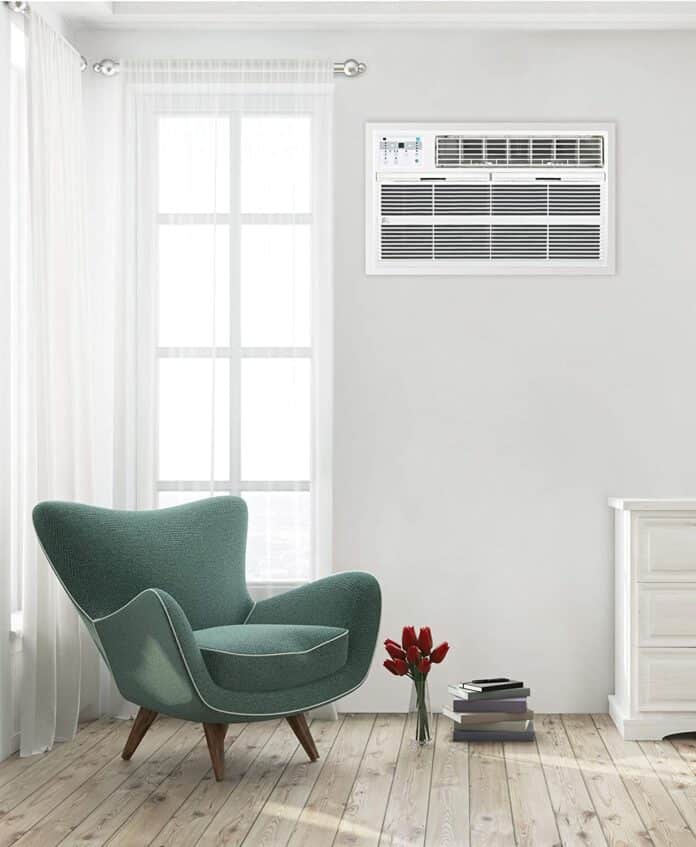Finding the right air conditioner could be challenging since various options exist.
Based on the type of space you want to cool down, it might be tough to know which one fits you.
And a kind of these different air conditioners is the through-the-wall air conditioner. We’ll get to know more about this type below.
Table of Contents
Top 5 Best Through-the-Wall Air Conditioners
Before we start the guide and learn new things, you need to understand Through-the-Wall Air Conditioners and check the best through-the-wall ACs on the market.
1. Koldfront WTC8001W Through-the-Wall Air Conditioner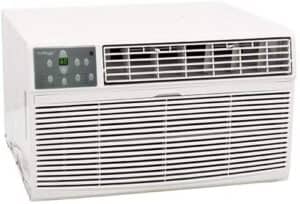
Koldfront WTC8001W is perfect for medium-sized places up to 350 square feet large. It can also heat spaces, but heating capacity is much lower – max 100 square feet in large areas.
This AC is very efficient and runs at a low cost. The unit is equipped with many features and the newest technologies – remote control, digital display, timer, thermostat, and more.
Pros
Cons
Verdict
2. LG 9,800 BTU Through-the-Wall Air Conditioner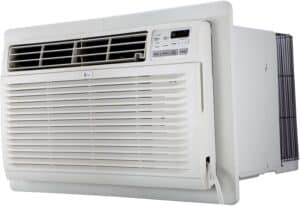
The LG LT1016CER Wall Air Conditioner provides excellent cooling without losing your window view. It has 9,800 BTU’s cooling power, and it can cool spaces up to 450 square feet large.
The unit has several features such as remote control, auto restart, washable filter, and more. LG AC allows you to adjust the air-flow direction using the louvers.
Pros
Cons
Verdict
3. Friedrich UE10D33C 10000 BTU Uni-Fit Series Room Air Conditioner with Electric Heat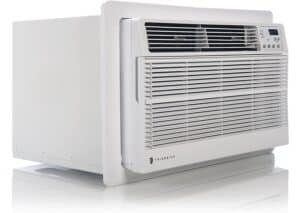
Friedrich Uni-Fit AC has a sleek design; it won’t take up much space in your room. This is one of the best choices for spaces up to 450 square feet AC.
Made for supreme comfort, with great cooling and heating. Friedrich Uni-Fit can be operated remotely using your phone and is also compatible with Google Home and Amazon Alexa.
Pros
Cons
Verdict
4. Perfect Aire 3PATWH14002 14,000 BTU Through-the-Wall Air Conditioner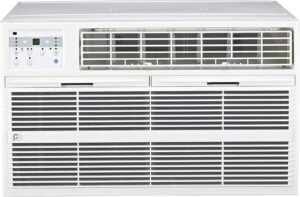
Perfect Aire provides an all-in-one house comfort solution. This AC comes with 14,000 BTU cooling power; it is easy to install and can cool spaces up to 500 square feet. So the unit is potent and, at the same time, energy-efficient with EER 10.5.
The unit provides many features, including automatic operating mode, remote control, nighttime operation, and more.
Pros
Cons
Verdict
5. Keystone KSTAT14-2HC 14,000 BTU Through-the-Wall Air Conditioner
Keystone 14,000 BTU Through-the-Wall Air Conditioner is one of the most powerful on the market. It can cover spaces up to 700 square feet and provide year-round comfort.
Despite its superb power, it has a 9.5 energy efficiency ratio. AC is equipped with several cool features such as remote control with a built-in thermostat, 3 cooling modes, auto mode, and more.
Pros
Cons
Verdict
What is a Through-the-Wall Air Conditioner?
The wall air conditioner is a unique air cooling device that has been around for several years. This kind of AC’s popularity is now at its peak since many people are looking for more affordable options for air conditioning.
Also, through-the-wall air conditioners are considered self-contained units. With this, the condenser, evaporator, and compressor are all inside the air conditioner. There is no need to install many parts.
These conditioners are also referred to as wall AC units or wall air conditioners. This is because they are installed on a wall instead of on a ceiling on in a window like other air conditioner devices. One side of the unit would face the room utilized to cool, while the other side would face the outdoor.
Wall air conditioners are unique because they don’t take up window space inside your home. And since it is installed on the wall, you can put them almost anywhere in your home, though a window doesn’t exist.
How Does It Work?
You should know that this kind of air conditioner works almost the same as the window air conditioner. So, once you’ve already used or seen a window air conditioner unit, you might already know almost 90% of how the through-the-wall ac unit works.
Like the window AC units, this air conditioner sucks in hot air through its large grill at the said appliance’s front. This air is then passed by a series of coils that use refrigerant from the device’s compressor to cool down the air.
If the air is cooled, it is pushed back into the room through the vents on top of the unit’s front. The hot air vent location is a factor that differs from a wall AC unit and window air conditioner. Window units would have them on the sides and the back for the wall air conditioners.
These vents expel hot air being generated by the unit to the outdoors. And this ensures that the hot air doesn’t find a way back to your room and spoil the air conditioner’s cooling efforts.
What to Consider When Purchasing a Through-The-Wall Air Conditioner?
As you begin shopping for this kind of air conditioner, several details could be helpful once considered. The following factors must be kept in mind:
Cooling Area
This one is indeed significant. The room size. Calculating the square footage or the room area is a lot easier than you could ever think. Measure the width and length and multiply the two to get the area.
In terms of triangular shapes, you must multiply the width and length as though it is a rectangle and divide the product by two. For a circular room, multiply the radius by itself and then by 3.14.
In most cases, a room is irregular when it comes to dimensions. With such, divide the room into measurable subparts as best as possible, then find the areas and add them all together.
Noise Levels
Sound intensity or loudness is typically measured in decibels or dB. The dB levels of an air conditioner are reported in the model’s description, and most wall air conditioners make between 50 and 60 decibels of sound.
So, all air conditioners, including the through-the-wall AC, make some noise; however, most people favor those who are quieter, particularly when the unit is in the house – in the bedroom specifically.
BTU or British Thermal Units
A BTU is the amount of thermal energy (heat) needed to raise the temperature of an lb. of water by a degree Fahrenheit. Be wary that BTU numbers are usually short for BTUs divided by the hour into AC units.
It is recommended that you might need an AC with almost BTUs of cooling for every square foot. It is also important to realize that buildings with high ceilings, multiple people, and many heat-producing machines need more cooling.
In the case of buildings that house more than two people, you can add about 600 BTU for every additional person. The kitchen might need an additional 4000 BTU. But, you can increase or decrease the total BTUs by almost 10% for shady or sunny locations.
Size
Through-the-wall air conditioners are not restricted by the size of the windows, as are the window units. Nevertheless, it would help if you had, or you need to, create a hole through the wall, which would at least fit your desired unit’s wall sleeve.
Good to know that most units of the same cooling power would fit in the same openings. Most air conditioners are about 25 inches wide, 15 inches high, and 20 inches deep.
EER Rating
EER Rating or Energy Efficiency is a standard efficiency rating intended for all air conditioners. This rating is calculated by taking the cooling capacity per hour, then dividing it by the energy required per hour. This tells you how much energy you might need to pay to get a given amount of cooling.
The majority of users, they want a high EER, which means more cooling for less. However, highly efficient air conditioners are a lot more expensive. Nevertheless, a good quality one would eventually pay back the extra cost in savings.
You can calculate the estimated yearly energy cost of the air conditioner based on an electric energy cost of 13 cents per kilowatt, 8 hours a day, and three months a year.
Heating Options
Some through-the-wall air conditioners could double as heaters. Well, this makes sense. Why? Because the air conditioners are also considered reverse heat pumps. It is still in the same mechanism yet in reverse.
However, some elements do not reverse the said cycle; they have the electrical heating element. Still, remember that most wall units are not enough to be the sole heat source unless you are in a very limited or small space.
They are just excellent supplemental heat sources to keep your garage warm or for a single room alone.
Size and Installation of Sleeve
Usually, this wall sleeve is a separate purchase from the air conditioner unit. It is a thin metal box that is open on two faces. You have to insert it into an opening in the wall and insert the AC unit into it.
Voltage
In the United States, the standard electric outlet is 115V. So, plug it in once the AC unit is designed to work in this said voltage. But, some AC units would need a 230V outlet.
That’s why it’s either you must have the special 230V, or you get a professional electrician to make one for you.
Dehumidification Levels
All air conditioner units dehumidify to some extent because lower temperature air doesn’t hold water either. Air conditioners release the extracted humidity in the form of water out the back of the exterior face by dripping.
With many units, however, this water tends to re-evaporate if it is heated by the warm exhaust of the AC and also by the warm outside air.
This dehumidification is then enhanced once fans slowly blow air over the cooling coils letting more air-water vapor condense. And this is generally what the dry mode on an air conditioner does.
Warranty
Normally, wall air conditioners have at least a year of limited warranties, and mostly, these are only for the parts of the unit and not the sleeves, electrics, covers, and more.
Some companies would have a warranty statement that lists what is being covered and not.
Usually, breakages and damages directly associated with the unit manufacture are not covered, such as electrical issues, malfunction from accidental abuse, and problems with the wall where the unit is installed.
Additional Features for Convenience
Look for a high-quality air conditioner unit that has multiple convenience features. Some units might allow you to operate the device using a smartphone or setting a timer, so the unit turns off and on once you want it.
Many have a sleep mode, which allows the room temperature to rise throughout the night before returning to the set temperature slightly. This would save energy and will keep you from waking up cold.
Another one is the energy-saver mode, which runs the fan by itself every 10 minutes or more. It would only turn back the AC once the temperature rises above your set temperature. Some also have a remote control, which might have a temperature sensor as a thermostat for the air conditioner.
Take note of these factors to buy the right through-the-wall air conditioner which would meet your expectations and needs.
What Are the Installation and Cooling Requirements?
If you plan to install a through-the-wall air conditioner in your home, you need to consider the room size where the unit would exist. In determining the size unit that you’ll need, begin with a suitable amount of cooling power.
British Thermal Units can be utilized to measure the cooling capacity of the unit. Please note that the higher the amount of the BTUs, the bigger the room would be cool.
Say, for instance, if your room measures 100 to 150 square feet, you would need a unit with 5000 BTUs. Or a room that measures 1200 to 1400 square feet would need 23000 BTUs of cooling power.
Aside from the room’s size, you must also consider other environmental factors, including the number of occupants, sunlight, and ceiling height.
- Number of Occupants. You have to add 600 BTUs for every additional person over two people for the cooling power.
- Sunlight. Also, consider increasing the unit’s BTUs by about 10% if you will put the cooling unit in a room that receives an abundance of sunlight daily. Or decrease the cooling power by 10% in a room with only minimal natural light.
- Ceiling Height. Estimating BTU is based on rooms having eight-foot ceilings. If you would install the unit in a room with a higher ceiling than eight-foot, increase the cooling power a bit.
Before installing a wall air conditioner, being equipped with the required factors would greatly help.
Are There Benefits in Using Through-the-Wall Air Conditioners?
There are several benefits if you prefer this kind of air conditioner. Many people would love to install this one over other kinds of AC. So, here are the benefits you’ll surely enjoy from investing in a through-the-wall air conditioner:
- It can double as a heater. Some units might offer you both heating and cooling functions. That is why this single device could cool you down during summer and warm you up during winter. And that is a lot cheaper than purchasing two separate appliances for indoor comfort.
- Year-round comfort. Indeed, this unit allows you to enjoy cool air anytime throughout the year. Even in colder months, if hot days pop up, there is no need to worry about suffering through the heat. It would already be stored away if you had this window-mounted air conditioner.
- Less Obtrusive. Using this unit, you don’t have to sacrifice a window in the house. This means you could still enjoy the views and open the window to get fresh air without worries or problems.
- No drafts. Through the wall, air conditioners slide into a sleeve inside the wall, providing you with a tight fit. And this design will prevent unwanted drafts from creeping in.
- Safer. A window-mounted air conditioner could easily be pushed and dislodged inside the house. This could make it easier for theft or burglar to break in. But, with a through-the-wall air conditioner, you are much safer because they are secured tight. Even if the unit were pushed through, it would be hard for an average individual to fit through the sleeve hole.
- Cheap to run. The average unit costs almost less than $30 a month to run for around 8 hours daily.
- Energy-efficient. Wall air conditioners are a lot more efficient than other types of air conditioners since you can cool a certain room independently. They are also more efficient because they have a tighter seal around the unit, preventing the cold air from escaping.
So, these are the benefits that you would surely love out of choosing to buy and install a through-the-wall air conditioner.
Frequently Asked Questions
Q: Can I install the mounted unit by myself?
A: Well, it depends on how many tasks you need to do too. Do you already have a suitable size on the wall? A wall sleeve? And how expert are you to do so? If you have the sleeve ready, lift the unit and slide it in, helping another individual. Or specialized help might be needed if there is a need to alter the electrics or the wall opening.
Q: How to install the sleeve of the wall air conditioner?
A: Consider the steps below:
- Find wall space or avoid an area with electrical, plumbing, or other household ducts or wires.
- Then, mark an outline of the hole to be cut.
- Next, cut its opening from the inside and take out the intruding wall studs. At about the perimeter of the opening, install a wooden support frame.
- Now, drill guide holes in the exterior and proceed to the cutaway opening.
- To make sure the opening is level, use a leveler. Or, if not, create fine adjustments.
- Here you have to put the sleeve in, affixing it to the opening. Follow the instructions and use the hardware that comes along with the unit.
- Finally, insert the air filter. It would help if you put the front grill on too. Apply insulation, and if you want, have a finishing frame to the wall that would surround the AC.
Q: Is there anything else I still need to consider when installing the said AC?
A: If the unit is a place already, unplug it first before removing it. If installing a new unit, do not plug it until you’re done with the installation and make a good location choice. Besides, consider the height that would reduce the chance of any unwanted problems shortly.
Q: How to seal through the wall air conditioner to the wall?
A: In most cases, wall ACs come along with foam inserts, which could be used in creating a weather-tight seal. Once needed, you can as well buy extra foam or weather-tight sealing.
Q: How to clean the unit without removing it?
A: Usually, there is a need for you to check or clean the filter about once every after two weeks, particularly if you are residing at a location with a lot of pollen, dust, or other fine particles in the air. You must also check the exposed front of the air conditioner for dust. Begin by turning the unit off, of course. Unplug the unit for safety if in case you anticipate doing more. It is also a good idea to lay some cover on the floor to catch falling debris.
In checking the filter, do the following:
- Please take off the front grill, which requires no unscrewing or flipping it down, up, or snapping it off.
- Second, slip out the air filter and clean it. Change it if needed. Wipe it using a damp paper towel, or if needed, you have to bathe it in water and soap, then let it dry.
- Once the dust is visible on the exposed front, brush it off. For a more serious residue, utilize a vacuum cleaner or a small brush to clean the unit’s exposed front.
Q: Are wall air conditioners more powerful than portable or window models?
A: Not so. The portable ones are not that energy-efficient, but they could have equal cooling power. Wall and window models are almost the same. Look at the BTU label, as this would indicate the cooling power.
Q: Can I comfortably sleep with this kind of AC?
A: Of course, yes! But, it would help if you considered the noise as you sleep. Be sure that your unit has an appropriate cooling capacity for your room size so it doesn’t cut off and on a lot. Also, this diminishes the dehumidifying effects of the air conditioner, making it a bit annoying.
Conclusion
Indeed, a through-the-wall air conditioner is a superb option that many people consider ver other types of air conditioners. And that is because of certain reasons. Discussed above are important details you should know about the said air conditioner.
Though there are various types of air conditioners and various brands and models, picking the right type that would answer your needs and guarantee satisfaction must always be your priority.
So, in picking the best through-the-wall air conditioner, take note of every single piece of information provided to you. And definitely, you’ll be able to find the right unit for you!

